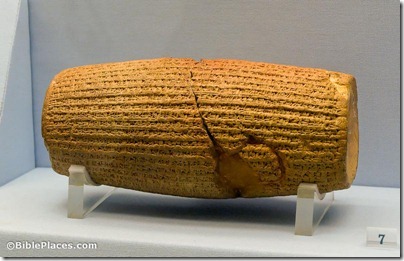From Art Daily:
The British Museum today announces that one of its most iconic objects, the Cyrus Cylinder, will tour to five major museum venues in the United States in 2013. This will be the first time this object has been seen in the US and the tour is supported by the Iran Heritage Foundation.
You have to skip to the end of the article to see where and when the object will be on display:
- Smithsonian’s Arthur M. Sackler Gallery and Freer Gallery of Art, Washington D.C., 9th March – 28th April 2013
- Museum of Fine Arts, Houston, 3rd May – 14th June 2013
- The Metropolitan Museum of Art, New York, 20th June – 4th August 2013
- Asian Art Museum, San Francisco, 9th August – 22nd September 2013
- J. Paul Getty Museum at the Getty Villa, Los Angeles, 2nd October – 2nd December 2013
What is the Cyrus Cylinder?
The Cylinder was inscribed in Babylonian cuneiform (cuneiform is the earliest form of writing) on the orders of the Persian King Cyrus the Great (559-530BC) after he captured Babylon in 539BC. It is often referred to as the first bill of human rights as it appears to encourage freedom of worship throughout the Persian Empire and to allow deported people to return to their homelands. It was found in Babylon in modern Iraq in 1879 during a British Museum excavation and has been on display ever since.
Neil MacGregor, Director of the British Museum, gave an interesting 20-minute talk on the Cyrus Cylinder at TED last year. The museum has posted a full translation of the inscription.
One caveat: visiting this exhibit does not excuse you from visiting the British Museum! (And before you go, you should purchase this excellent guide.)
HT: Jack Sasson

3 thoughts on “Cyrus Cylinder Coming to the U.S.”
Personally I have found Fant, Clyde E., and Mitchell G. Reddish. Lost Treasures of the Bible — Understanding the Bible Through Archaeological Artifacts in World Museums. Grand Rapids, MI: Eerdmans, 2008 to be very useful at the British and other museums (actually more so). IMHO their breadth and depth of coverage is more complete.
I was tempted to add that book in, but I decided to limit the recommendations to one. I chose Masters' work because it is a better guide to the British Museum itself, with lots of maps, photographs, and room numbers to help the visitor find his way around this otherwise overwhelming museum.
Fant and Reddish organize their excellent book by periods and while the museum index is helpful to sort it out, I'd prefer to use F/R at home and Master on location.
(I also prefer the more conservative approach of Masters. F/R say, for instance, "The book of Daniel is well-known for its historical inaccuracies.")
I have to say, it would really honk me off if I traveled half way around the world to visit the British Museum and see they cylinder and find out it was somewhere else.